The Ultimate B2B Outbound Marketing Strategy: Cold Email + Direct Outreach

Founder, Mura Digital
Updated: January 20, 2024
Published: January 17, 2024


"If you can't generate B2B leads after this, I've got nothing for you."
Hey there, I’m Mishka Sidlin, the owner and founder of Mura Digital and this is our exact outbound marketing process, step by step, that we have been using now for over 2 years to scale our B2B company from $2,000 / month to over $24,000 / month.
This somewhat complicated strategy literally changed my life and I hope it does the same for you and your business.
The first 3 years at Mura Digital were rough – we were either doing great with sales or service, but rarely both at the same time.
Sales were sporadic to say the least, and we all know you need a consistent flow of sales for any successful business.
Here’s what I did: I read dozens of books, bought tons of courses and learned from industry leaders to finally nail down a cold outreach method that works for our agency and our B2B clients.
Why am I sharing it? Well, because I know there’s more than enough business for everyone.
When I first started, something like this would’ve saved me so much time and stress. I found other strategies but everything seemed a little too vague, nothing was ever this detailed and direct. It also seemed like everyone wasn’t giving their secret sauce.
Here’s the secret sauce.
The secret sauce is that 99% of people that try to do this will cut corners. This doesn’t work if you cut corners. It requires manual work, though parts of this are automated. It’s a lot of work, but it absolutely works. We are the living proof, and so are our clients.
In fact…
I promise if you follow each and every step in this guide, you’ll generate leads for your B2B business on a consistent basis.
If you try this exact strategy for at least 90 days and it doesn’t work for you, reach out to me here and we can talk 1-on-1 to walk through your campaigns together, free of charge.
And just so you know… this strategy works for ALL types of B2B businesses – even local service businesses targeting commercial work, like roofing companies:
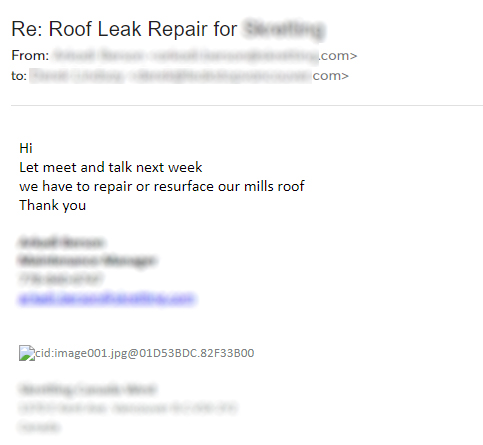
With all that being said, let’s dive right in.
Our B2B Outbound Marketing & Sales Strategy
Step 0: Form a GREAT Offer - The Foundation of Your Marketing
Objective: Develop an offer that resonates powerfully with potential clients, making you the obvious choice in your industry.
Understanding Your Market
Identify Your Niche/Industry: Choose a specific niche or industry you want to target.
This allows you to tailor your messaging and value proposition to meet the specific needs and pain points of that exact audience.
Market Research: Research your potential customers to understand the needs, pain points, and desires of your target market.
Identify gaps in the market that your offer can fill. Literally interview them, be genuinely curious. This can even lead to clients if you do it right.
Study The Competition: Analyze your direct competitors’ offers.
Understand what they are offering and how your offer can provide more value in a specific, logical way.
Pro Tip: You don’t want to be the cheaper option. Your goal should be generating more value for the same or a higher price.
Learn From Marketing Experts
Expert Level Offers: Look up successful examples of offers in your industry. A great book on designing your offer is “$100M Offers” by Alex Hormozi.
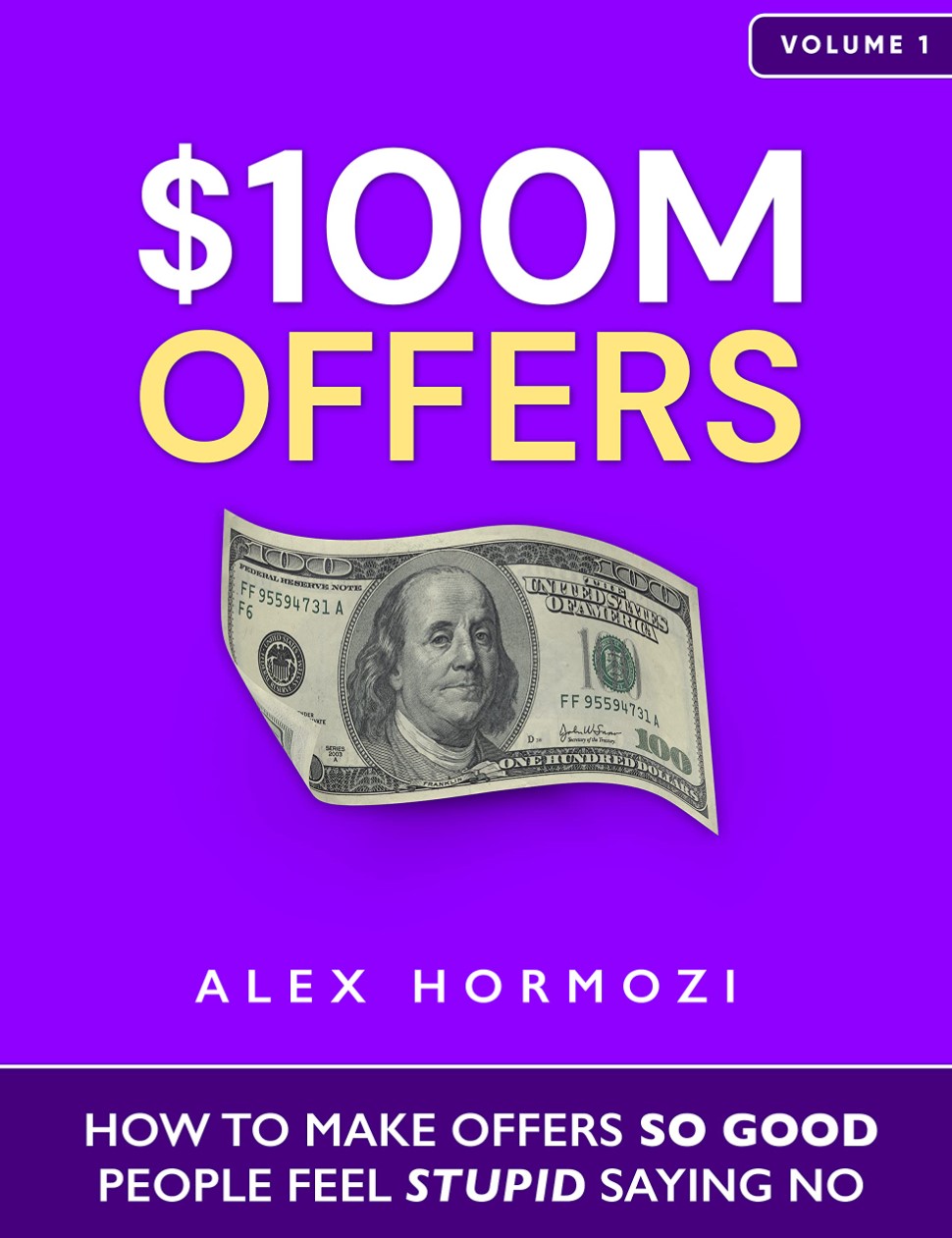
Don’t Reinvent The Wheel: All you need to do is look up your most successful competitor, study the successful offers, add your own relevant dynamic and principles that align with your business model and target audience. This strategy is called ‘Funnel Hacking’.
Creating Value With Math & Logic
Value Proposition: Your offer should have a strong value proposition. It must clearly demonstrate the benefits and the return on investment (ROI) that your clients will receive.
Quantifiable Benefits: Make the benefits of your offer quantifiable – think about your deliverables.
Prospects should be able to see the tangible results they can expect, whether in terms of revenue, time savings, cost reductions, etc.
Leveraging Pricing Strategies
Pricing Psychology: Use pricing strategies that make your offer more attractive. This might involve bundling services, offering tiered pricing options, or presenting the pricing in a way that highlights the value.
Risk Reversal: The most effective offers include elements of risk reversal, like money-back guarantees or free trials. This reduces the perceived risk for the client so they can make the decision easier.
Building the Campaign Around the Offer
Consistent Messaging: All of your landing pages, sales pitches and email copy should be aligned with the core message of your main offer.
Adaptability: Be prepared to adapt your outbound campaign based on feedback you receive. Monitor engagement and be ready to tweak aspects of the offer or its presentation based on client feedback and your conversion rate.
Tiered Pricing Offer Example
Here’s an example of our tiered pricing offer for B2B Outbound Marketing & Lead Generation
Step 1: Landing Page Design - Your 24/7 Digital Salesperson
Objective: Develop a targeted, compelling landing page that addresses your potential clients’ questions, concerns and aspirations.
The Basics of a Landing Page
Layout: Make your landing page easy to navigate. Key information should be above ‘the fold’ (visible without scrolling).
Mobile Responsiveness: Your landing page needs to be mobile-friendly because more people use phones than they do computers.
Loading Speed: Optimize for fast loading times. Slow pages can lead to high bounce rates – there’s nothing worse than a wasted click.
The Essential Components of a Highly Converting Landing Page
Value Proposition: Remember that people buy things based on emotion, then justify the purchase with logic. Knowing this, we should clearly articulate the value your service provides using human emotion.
It’s even better if you do this with a ‘story’. This should be placed at the top of the page, and should concisely convey how your service solves a problem or adds value to your ideal customers.
Social Proof: Use testimonials, client logos, or case studies to build credibility and trust. This shows potential clients that without a doubt, you can provide the results you’re boasting.
Case Studies/Previous Results: Showcase detailed case studies or examples of previous results. Be specific with figures, using dollar amounts over percentages when possible.
These should demonstrate your expertise and the tangible benefits clients have received from your service.
Clear and Singular Call-To-Action (CTA): Your CTA should be focused on one action: scheduling a sales call – nothing more. Make your CTA button stand out from all the others and display it multiple times on the page.
Visual Elements: Use high-quality images, videos or graphics. Visuals should complement your text, making the page more engaging and helping to convey your message.
Helping Your Visitor Envision the End Result
Use of Similar Language/Jargon: Use relatable language to help visitors relate to and imagine the outcomes of your service.
Eye-Catching Figures: When talking about case studies, use specific dollar amounts or figures instead of percentages. Seeing dollar amounts can be more eye-catching than percentages or multiples.
Examples:
“$748,000 of additional sales” sounds a lot more exciting than “raising your conversion rate by 1%”.
“Saving $83,700 per year” has more shock value than “reducing expenses by 8%”.
Landing Page Example
Here’s an example of our Landing Page for Wedding Photographer SEO
Step 2: Video Sales Letter (VSL) - Addressing Questions Before They Arise
Objective: Create an engaging and informative video for your landing page. With a properly designed VSL, many of your leads can be ‘pre-sold’ on your services by getting their concerns addressed during your video.
You read that correctly – Your sales can close themselves before you even meet your new leads with an effective VSL.
What Should Your VSL Look Like?
Introduce Yourself: Start with a personal introduction. Seeing a face and hearing a voice builds a human connection, which is essential in gaining trust.
Explain Your Offer: Clearly describe what your service is, how it works, and the benefits it provides. This should align with the value proposition on your landing page. Mention case studies and remember to start with emotion and end with logic.
Address Potential Questions: Anticipate and answer common questions that prospects might have. This removes their excuses and makes sales calls easier.
Questions To Address: These questions are different for every business and every offer, but basically they’re the ones you’ve been asked on previous sales calls.
Example Questions:
- How do you solve the common pain points for your niche?
- What makes you unique?
- What results have you achieved for others? Be specific.
- I see you’ve done this for others, but how can I be sure you can do this for me?
- What is the process of working with you?
- What is the expected ROI or outcome?
- How do you support clients post-implementation?
- How can I get started?
Direct CTA: End your video with a clear call-to-action. Encourage viewers to schedule a sales call or take the next step in your sales process.
Strategic Placement: Embed the video towards the top of your landing page. Many leads will watch the video and take immediate action – It’s that powerful.
Video Production Tips
Quality Matters: Ensure the video is of high quality. Good lighting, clear audio, and a professional backdrop reflect positively on your brand.
Keep it Concise: Aim for a video length that’s long enough to be informative but short enough to maintain engagement. 2-5 minutes is a good range.
Engaging Presentation: Be enthusiastic and genuine. Your energy can be contagious and can help keep viewers engaged.
Video Sales Letter Example
Leveraging YouTube for Traffic and Trust
YouTube Channel: Host your video on YouTube. This allows you to drive traffic from YouTube to your landing page.
Additional Content: Consider creating more videos related to your service or industry and posting it on your YouTube channel. When someone researches your brand, this further establishes your expertise in your industry.
Attracting Leads While You Sleep
Results From Your VSL: When your VSL is set up correctly, you’ll start to get calls from prospects that are ready to buy ASAP. They’re pre-sold!
We regularly receive voicemails like this:
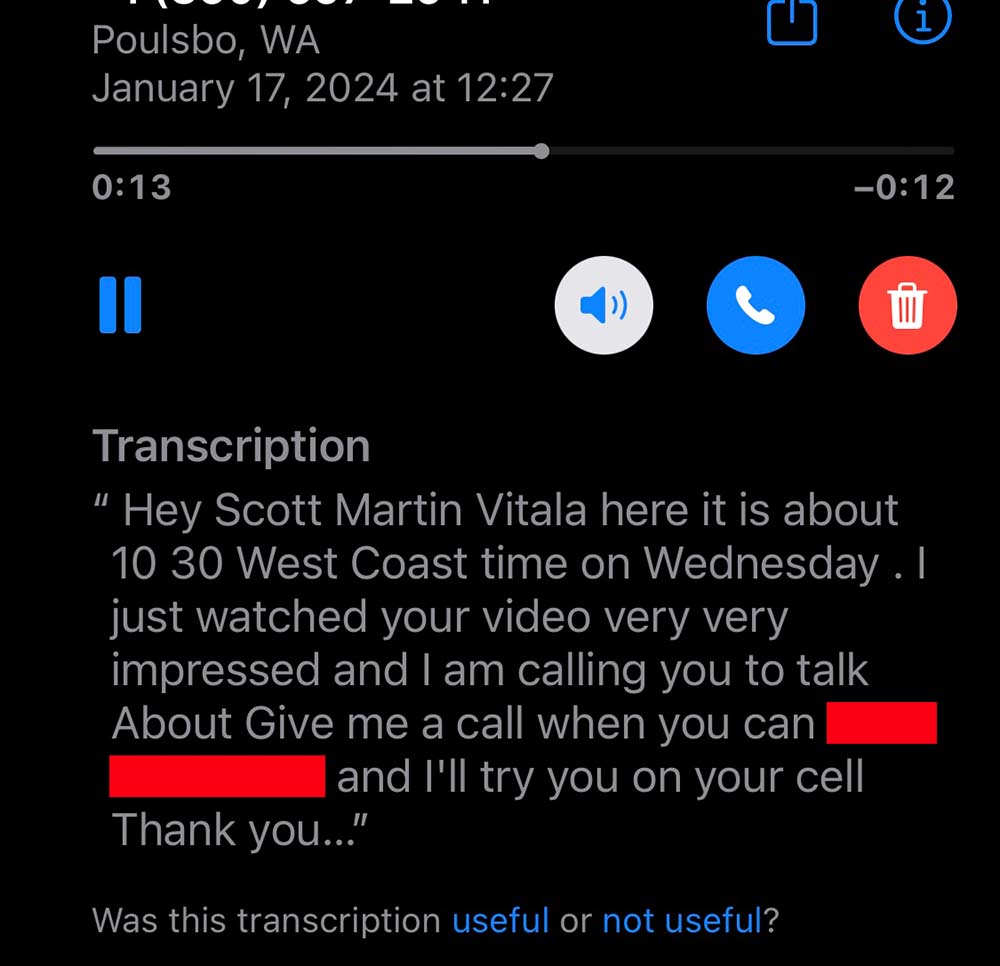
Step 3: Cold Email Setup - Automating Outreach
Objective: Use specialized domains for cold emailing campaigns to convert prospects into leads at scale.
Burner Domain Setup
Similar Names: Choose domain names that are relevant to your business or offer. They should look similar to your main domain.
Multiple Domains: Purchase several domains to diversify your outreach efforts. We recommend a minimum of 5-10 domains, sending at most 35 emails per domain, per day.
Redirect Your Domains: Redirect your burner domain to your landing page URL. People will copy/past your burner domain and when they do, you want them to land on the landing page you designed specifically for them.
Email Account Setup
Dedicated Email Accounts: Create 1 email account for each burner domain. Never, ever send cold emails from your main domain.
Email Account Names: You’ll want to mimic an email address from a real person at a real company. You can keep it short with just a first name @ your domain, first name last initial, or something similar.
Pro Tip: If you’re a solopreneur or freelancer, I suggest using a name other than your own. This makes you look like a bigger operation and as such, even if subconsciously, prospects are willing to pay more.
If anyone asks, just say your fictitious name “is my email appointment setter, they don’t join sales calls, they only gauge initial interest.” This is a common business practice.
Email Sender Setup
Automated Email Sender: We won’t make any recommendations on a specific email sending platform, but we do recommend you use one that has good reviews. We currently use Instantly.
Technical Setup: This part of the setup is slightly technical. If you don’t know how to do this, Google it or ask your email sender’s support team.
MX Records: Whichever email sender you use will have you setup MX Records to connect each email account you will be using. This is required to send and receive emails in your automated software.
Domain Authentication: Each domain needs proper SPF (Sender Policy Framework) and DKIM (Domain Keys Identified Mail) records set up. This is crucial for email deliverability and to prevent emails from being marked as spam.
DMARC Records: You’ll need to setup DMARC records. These needs to be setup at minimum 2 days after you setup your SPF & DKIM records.
Email Warmup Process
Automated Warm-Up: We use an email warming service.
These services automate the process by sending emails to a network of email accounts and then engaging with these emails. Many email senders offer free email warmup as part of their subscription.
Duration of Warming: We warm up our accounts for a minimum of 30 days.
This is why we recommend setting up at least 10 accounts so your outreach never slows down in case one (or some) of them get marked as spam. Once marked as spam, you can forget about using that account since it’ll just land in spam folders going forward. You’ll need to buy a new burner domain and start the setup / warm-up process all over again for the new domain.
Step 4: Building a Highly Targeted Lead List
Objective: Compile an extremely targeted list of business leads. All of this hard work doesn’t matter if you’re sending emails to the wrong people.
Better leads = better results.
Targeted Lead Sourcing
Ideal Customer Profile (ICP): Define your Ideal Customer Profile. This includes industry, company size, geographic location, and other relevant characteristics.
Alignment with Offering: Ensure the leads you gather align closely with your ICP. This increases the likelihood of your outreach resonating with the prospects.
Purchasing Leads: You can purchase lead lists from reputable providers. Lead quality varies greatly, but do your own research.
Manual Gathering: Alternatively, manually gather leads by researching businesses. Use platforms like Google Maps, LinkedIn, industry directories, and business databases.
Essential Details: At a minimum, gather the business name, key contact person’s first and last name, direct phone number, and email address.
Cleaning / Verifying Your Lead List
Use Lead List Scrubbers: You can use an email list cleaner / verifier / scrubber to automatically check the validity of your email list. We use NeverBounce.
Only Send Emails To Valid Addresses: You should avoid sending emails to ‘catch-all emails’ and other invalid addresses so you keep your email bounce rate low and avoid being flagged as spam by the email servers.
Enhancing Your Lead List
Unique Details: This is a manual process, but is necessary for a high positive reply rate. You should gather one specific detail that is unique to their business so you can mention this in your email.
Example: If a “Platinum Photography Package” is the exact name of something being sold by your prospect, jot that down in a new column on your lead list. You can name that column ‘Unique’. We’ll pick back up on this later in the guide.
Step 5: Email Campaign Design
Objective: Implement an automated email campaign that aligns with your goals and outbound marketing best practices.
Choosing an Email Sending Platform
Software Selection: Choose a reliable email sending software. Look for features like automation, customization options, analytics, and integration capabilities with CRMs. As stated above, we currently use Instantly.
Automation Setup: Configure automation for sending emails. This includes setting up triggers for follow-up emails based on recipient actions like opens, clicks, or lack of response.
Personalization & Customization
Segmentation: Segment your email list based on criteria like industry, lead source, or engagement level. Tailored messaging to each segment increases relevance and response rates.
Dynamic Content: Use dynamic content that changes based on the recipient’s data. This can include their name, company name, or other relevant details.
Unique Dynamic Content: Remember the ‘Unique’ column you created in your lead list? Now you have a specific, unique phrase to be used in your email that lets the lead know that you actually took the time to research them and understand who they are.
Again, this will absolutely increase positive reply rate, but because it has to be manually done, many people skip this part… and that’s why so many fail at cold email. Don’t be like them. Take the time, do it right.
The Ideal Email Campaign Copy
Conversational Tone: Write in a candid, human-like manner. Avoid sounding robotic or overly formal.
Understand Your Audience: Adapt your writing style to match the preferences and professionalism of your target audience. Industry-specific jargon may be appropriate in some cases.
Use Dynamic Content: Use dynamic content in your emails, like the lead’s first name, company name and unique content we spoke about earlier in this article.
Implementing Spintax: Use Spintax (or liquid syntax) for creating variations in your email content and sounding more human and less robotic. Spintax allows you to automate your customizations depending on specific criteria.
Example Email Copy: “Hey Todd, Happy Friday! Did you receive my last email?” In this example, the first name, Todd, is Dynamic Content and the word Friday is Spintax that changes depending on which day of the week the email is sent by the system.
Email Copy Structure: Hook, Story, CTA
Hook / Subject Line: Your subject line should be eye-catching and pique curiosity.
These are some of our favorite things to include in a subject line:
- First Name
- An enticing question about their business
- Including the Company Name
- A specific product or service they sell that is unique to them (from your ‘Unique’ column)
Story / Body: Focus on the recipient’s potential needs or pain points, while explaining how your solution can help them along their journey of getting those needs taken care of. Story-telling is powerful here, but be concise. Case studies are your friend here.
Clear CTA: Include a clear, easy call-to-action. Guide the recipient on what to do next – our highest converting emails are a simple yes or no question.
LEAD MAGNET / FREE VALUE: This part is huge. The easiest way to get a positive reply and continue to the sales process is to offer them something that is HIGH VALUE for free. This is another manual process, but it’s so worth it.
Example: One of our best converting lead magnets is a free website audit and SEO action plan. This not only displays your knowledge, creating even more social proof, but it’s genuinely a nice thing to do.
We found that if you’re just genuinely nice, people tend to be genuinely nice back. Crazy concept, right?
Natural Follow-Ups: Include follow-ups that sound natural, like referencing a previous call or interaction.
Urgency: Create a sense of urgency with your conversation. We like to get creative here and tailor this based on our ‘story’. I’m not at all saying you should put a time limit on your offer, but if you get creative enough, you can do something similar.
Example: One of our highest converting campaigns that displayed a sense of urgency was simply letting the prospects know that we don’t typically do cold outreach for new clients, but “I’m on vacation, I stumbled upon your website. I’m a workaholic, and frankly, bored at this all-inclusive hotel. So if you reply in the next couple days before I finish my vacay and get swamped with work again, I’ll record a quick video for you because I saw some things that could use optimizing.”
Step 6: Cold Calling - The Not-So-Automated Part
Objective: Establish a personal connection with leads and differentiate yourself from other cold emails through phone calls.
Warm Calling, Not Cold Calling
Call The Same Day: Call the leads on the same day you send them an email. We typically use this tactic for our 2nd follow-up sequence, but you should test what works best for your campaign.
Preparation: Have your email content fresh in mind and use it as a reference point in the conversation. Research the company for 30 seconds before dialing, have their website up on your computer or phone.
No Answer: Leave a voicemail explaining who you are and refer to the cold email you already sent to them.
Scripting and Flexibility: Prepare a call script, but use it as a guideline rather than a rigid set of statements. We call them ‘sales call cheat sheets’, not scripts.
Reference the Email: Mention your cold email early in the call. This provides context and makes the call less intrusive, making the call feel less like a cold call and more like a follow-up with a warm lead.
Tone & Engagement: Focus on engaging the lead in a conversation rather than delivering a monologue.
Sales calls shouldn’t feel like sales calls. People love talking if you give them a chance to open up. Ask open-ended questions, listen to their needs and respond accordingly. Your tone typically dictates how they react to your call. Mirroring your prospect’s tone is a common tip for phone salespeople.
Follow-Up Action: End the call with a clear next step, whether it’s scheduling a more detailed discussion, sending additional information, or another call.
Receiving Calls From Prospects
Be Prepared For Calls: Because you’re making calls and leaving voicemails, you need to be ready at all times to answer your phone.
Call Prospects Back ASAP: If you don’t answer your phone, be sure to call your prospects back immediately after they leave a voicemail.
We found that an immediate call back is astronomically more effective for landing clients. You need to speak to them when they’re in the mood to speak to you, and you’re top of mind.
Step 7: Cold Social Media Outreach
Objective: Expand and diversify your outreach efforts by connecting with your leads on social media platforms.
Social Media DMs & Comments
Platform Selection: Choose the most appropriate social media platform for each lead. LinkedIn is ideal for B2B outreach, but we’ve also had luck on Twitter (X), Facebook and Instagram.
Messaging Etiquette: Be professional and courteous in your message. Reference your previous email, but don’t hit them with a CTA. Be friendly, add them or connect with them, then once they reply you can go for a CTA. The goal here is nurturing a lead and not sounding like a robot.
Content Sharing: Share relevant content or insights that might interest the lead. Having fresh, high quality content can position you as a knowledgeable figure in your field and increase your reply and conversion rates.
Comment Strategy: Comment on your leads’ posts with relevant, valuable information. Do not mention your cold email, messages to them or anything else not related to their post. The goal is to nurture a real, genuine relationship and prove you’re not just a bot.
Long Term Strategy: Long term strategies are what separate the rookies from the veterans in sales.
Use social media at least once a week to share useful information or to comment on posts, keeping your name visible to the new people you’re connecting with.
Don’t make it about a sale, instead just be happy that your network is growing. Your newly expanded network is a goldmine for potential clients in the future, even if now isn’t the right time. You’re curating a network of industry professionals that may need you some day.
Step 8: Follow-Up Schedule - Maintaining Consistent Engagement
Objective: Implement a systematic and persistent follow-up strategy with leads.
Creating a Follow-Up Calendar
Number Of Follow-Ups: There is a delicate balance between sending enough follow-ups to be effective, and sending so many that you annoy people so much that you’re getting marked as spam. We use at least 6 follow-ups at Mura Digital, at most 12.
That may seem excessive… but get this: 60% of sales happen after 5 follow-ups. 80% of sales happen between the 5th and 12th follow-up.
The funny part? 44% of salespeople only follow-up once. 92% of salespeople only follow-up 3 times.
Ding! Ding! Ding! There’s your opportunity.
Frequency: Determine how often you want to follow up with your prospects.
Diversified Approach: Vary the follow-up methods, alternating between emails, calls and social media messages.
Tailored Messages: Customize each follow-up based on the lead’s previous interactions and responses. Reference specific points from earlier communications to create a sense of continuity.
Value Addition: Most follow-ups should provide additional value or information, rather than just asking for a response.
Pro Tip: Here is our highest performing follow-up frequency strategy.
Initial Cold Email
Follow-up #1: 2 days later, email + phone call
Follow-up #2: 4 days later, email + social media message
Follow-up #3: 4 days later, email + phone call
Follow-up #4: 4 days later, email + social media message
and so on…
Persistence vs. Respect
Respect Boundaries: While persistence is key, it’s also important to respect the lead’s preferences. If a lead indicates they are not interested, adjust your strategy.
Extended Timeline: Understand that some leads might take months or even years to convert. Maintain a long-term follow-up plan for these leads, keeping in touch periodically without being intrusive.
Final Message: Send a closing message to unresponsive leads, leaving the door open for future engagement and ensuring a professional end to your messages.
Long-Term Relationship Building
Beyond Immediate Sales: Understand that cold outreach is also about building long-term relationships. Even if a lead says no today, they could be a valuable connection in the future.
Maintaining Professionalism: Always respond professionally to any feedback or rejection, leaving a positive impression that could lead to future opportunities.
Step 9: Analyzing, Adapting, Optimizing
Objective: Study your campaign analytics on a regular basis and make optimizations based on your data.
Tracking and Optimizing Results
Campaign Analysis: Regularly analyze the statistics of your outreach efforts. Look for patterns in responses that can guide your future strategy.
A/B Testing Strategies: You should be regularly testing different strategies and styles of writing. What works for one industry or offer might not work for another.
Adapting Tactics: This is not a ‘set it and forget it’ strategy, that’s how you fail. Be ready to adapt your approach based on the feedback and responses you receive. This could mean tweaking your message, targeting different industries, or even changing up your offer.
Incremental Improvement: Focus on incremental improvements in response rates and engagement levels, rather than unrealistically high conversion goals.
What Are Good Cold Email Stats?
Reply Rate: 4% is a good reply rate for cold email campaigns.
Positive Reply Rate: 1.5% and above is a great positive reply rate. Positive replies are people asking for more information or scheduling a sales intro call.
Booked Call Rate: 0.5% – 1% of all of your leads should result in a booked sales or demo call.
Example: If you have a great performing campaign sending emails to 1,000 leads, you should get 40+ replies, 15+ positive replies, and 5-10 booked sales calls.
Once you achieve these numbers, you can start to scale that particular campaign.
If you’re not seeing these kinds of results, don’t bother scaling yet – you probably cut corners somewhere or simply haven’t tested long enough.
Unlike every guru out there selling courses, I’m actually going to be honest with you.
You will not see good results on your first campaign.
Good results will only be achieved after at least a few campaigns and plenty of trial and error.
Our Cold Email Statistics For 30 Days
Below, you’ll see the results we achieved in just 30 days from December 2023 and January 2024.
7-10 days of that time, we actually deactivated a few of our campaigns due to Christmas and New Years.
What would 21 sales calls per month do for your B2B business?
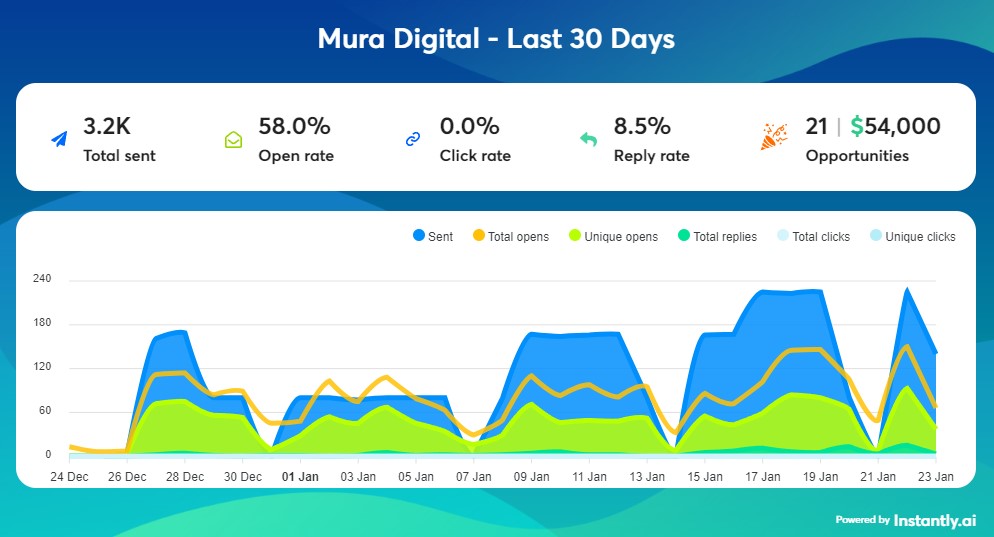
Step 10: Scale Your Outreach, Maximize Results
Objective: Pick your best performing campaigns and scale those like there’s no tomorrow.
Scaling Your Best Performing Campaign
Campaign Size: We like to test our campaigns in batches. 1,000 leads is our typical ‘testing’ campaign size, and if it doesn’t perform well, we optimize and test different copy and strategies.
Scaling The Campaign: Once you figure out which of your campaigns got you the best results, it’s time to scale it to the max.
You can take your successful campaign and instead of just sending it to 1,000 leads, you can send it to 10,000 or 100,000.
Don’t Scale Too Soon: You can scale this as big as you want, but you don’t want to do this right away.
It will take at least a few campaigns to figure out which ones are winners. Launching a bunk campaign to qualified leads is one of the worst things you can do for your brand image. First impressions matter.
Don’t Forget The Manual Work: This part is big. Remember that the reason this method is so effective is because there’s manual work involved.
Most people just want something automated with no manual work. Even if you have winning copy, without the manual work like the ‘unique’ column or warm calling, you simply will not see the same results. We know this from experience.
Learn from our mistakes, always do the manual work.
Understanding The Goal Of Outbound B2B Marketing
Not every person you reach will be a yes, in fact, 99% will be a hard no.
Shift your focus from getting a yes to simply obtaining a response, whether positive or negative.
Outbound marketing and cold outreach is about proactively finding leads and filtering them to find the ones that just happen to be looking for your products or services.
It’s a numbers game.
Understand that a NO can be just as valuable as a YES. Even negative responses provide insights into your copy and help you refine your targeting.
You cannot take the responses to your campaigns personally – even if you get good responses. If you did good, it was because you used the right formula. If you did bad, it’s because you used the wrong formula. Learn from your previous campaigns and move forward.
Remember that rejection is the price we pay for optimization.
If you’ve read this far, you probably realize this will be a lot of hard work and take plenty of time.
There’s no mystery for you anymore. You have the blueprint – you have no more excuses aside from simply not putting in the work.
The truth is you probably won’t have a super successful campaign on your first try, it takes a ton of optimization and experience. It can take a few months, but if you follow these steps you’ll see success, no doubt.
The only real shortcut to getting results is to hire someone that’s done it hundreds of times already, and if that’s where you’re at, click here to see our B2B services.

Founder, Mura Digital
Updated: January 20, 2024
Published: January 17, 2024
